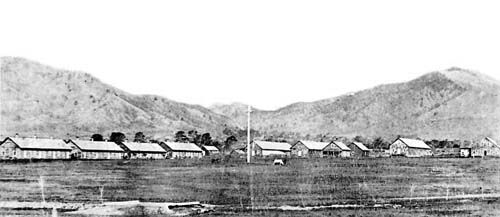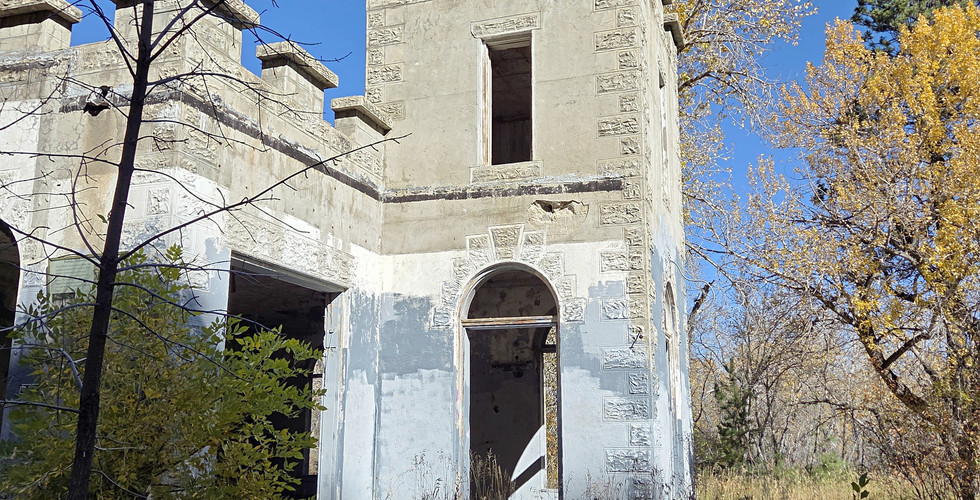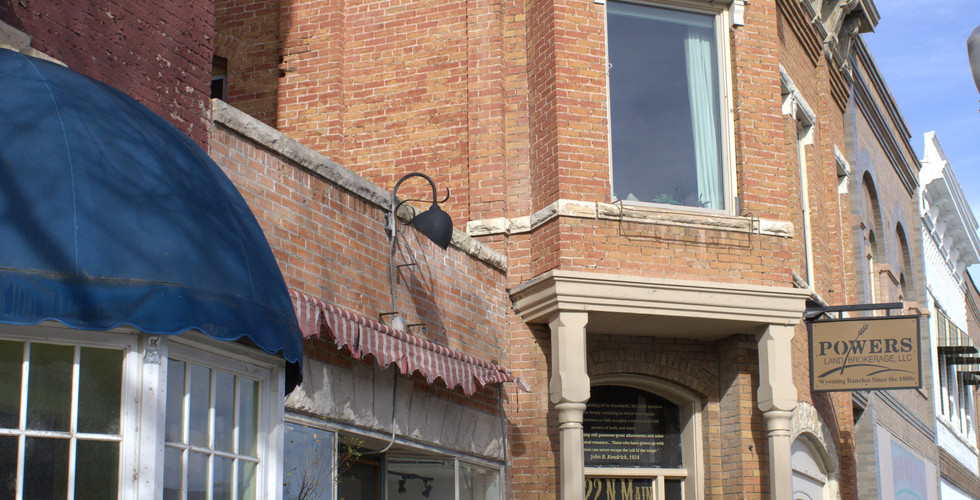Exploring Buffalo Wyoming and Sheridan Wyoming
- Grant

- 7 days ago
- 6 min read

With the snowcapped peaks of the Bighorn Mountain range (BighornMountains.Com - About the Bighorns) as a seeming impenetrable barrier to the west, we drove north-by-northwest from Greeley, Colorado to Buffalo, Wyoming (Buffalo, Wyoming - Wikipedia).
With Buffalo Wyoming as our homebase, we intend to travel west across the Cloud Peak Highway (Cloud Peak Skyway Scenic Byway) to Ten Sleep (Ten Sleep, Wyoming - Wikipedia) on the first day.
On the second day, we are going to the Little Big Horn Battlefield (Little Bighorn Battlefield National Monument (U.S. National Park Service)) in Montana, with a stop in Sheridan, Wyoming (Sheridan, Wyoming - Wikipedia).

It was about a four-hour drive from northern Colorado to Buffalo, Wyoming, including a quick stop for the dogs in Douglas, Wyoming (Douglas, Wyoming - Wikipedia) — home of the Jackalope.
Buffalo Wyoming
We arrived in Buffalo Wyoming with about two hours to kill before we were able to check-in to our hotel rooms. So, we took the dogs on a short hike on the Mentock Trail, along Clear Creek (That's Buffalo Wyoming! - Clear Creek Trail System) which flows from the Bighorn Mountains into Buffalo and beyond (Fly Fishing Buffalo Wyoming | Close to Town Fishing).
Wyoming has an incredible number of creeks, most of which empty into several large rivers, like the Powder and the Platte with their numerous forks.
Ownership of all of this water is critical in the western US, especially for the drier states. Water rights law is a huge area of legal practice and has made many lawyers and water rights owners very rich (Water Rights in Wyoming: A Guide for Property Owners - Century21 BHJ Realty, Inc. Blog).
Back to early Buffalo… The settlement that would become Buffalo began adjacent to Fort McKinney (Fort McKinney (Wyoming) - Wikipedia), one of many forts established to protect settlers and ranchers from the Sioux, Cheyenne, and Arapahoe Indian tribes. These tribes used the area primarily for hunting.
As the settlers continued to move into the area, more forts were established along the Bozeman Trail (A Brief History of the Bozeman Trail | WyoHistory.org) — an off shoot of the Oregon Trail used by settlers to travel into northern Wyoming and Montana.
Historic photos from Wyoming State Archives (Cities & Towns - Buffalo #5 of 5 - Wyoming State Archives Photo Collection).
The rich history of Buffalo, Wyoming — named after Buffalo, New York not the American Bison — includes numerous battles with the Northern Plains Indian tribes; the Johnson County Cattle Wars of 1892 (The Johnson County War: 1892 Invasion of Northern Wyoming | WyoHistory.org); outlaw hideouts like the Hole in the Wall for Butch Cassidy and the Sundance Kid (The Hole in the Wall: Wyoming’s Wild Den of Thieves - Historic Mysteries); and the immigration of Basques (Basques in the American West - The Basque Museum & Cultural Center | Boise, ID) and emergence of sheep ranching.
Today, Buffalo Wyoming is a quaint little town with a population of about 4400. The people are very friendly and helpful. You can find excellent restaurants, first class lodging, and stores for souvenir items and any necessity you may have forgotten at home. While you are there, take time to drive away from Main Street and see some beautiful old homes.
If you are feeling more energetic, you have several choices of trails in and around town. I mentioned the Mentock Trail which is part of the Clear Creek Trail System (That's Buffalo Wyoming! - Clear Creek Trail System) going west of town.
The Greenbelt Portion begins off Lobban Avenue one block east of Main Street and heads east for about four miles.
While in downtown Buffalo be sure to visit the Jim Gatchell Memorial Museum (Jim Gatchell Memorial Museum | Buffalo WY), at 100 Fort Street, in the building immediately adjacent to the Johnson County Courthouse.
The museum contains the artifacts and collections of Jim Gatchell (Jim Gatchell Memorial Museum - Wikipedia), one-time local pharmacist, collected from the early 1900s until his death in 1954. Beautiful artifact and diorama displays from most of the major historic events around the Buffalo, Wyoming area. Highly recommended.
Cloud Peak Highway and Ten Sleep
The Cloud Peak Scenic Skyway (Cloud Peak Skyway Scenic Byway) is a beautiful drive up through the Bighorn Mountains (Big Horn Mountains and Bighorn National Forest Wyoming information - BigHornMountains.Com). Awesome cliffs and rock formations, along with breath-taking views of 13,000 foot+ snowcapped mountain peaks.
A bit of a winding road through the mountains, surrounded by striated cliffs and colorful rock formations, the drive to the small village (don’t blink or you will miss it) of Ten Sleep took about an hour and twenty minutes. That includes a stop for the dogs and a couple of stops for photos. So, a nice drive.
The drive passes several campgrounds and scenic overlooks. Before reaching Ten Sleep, we passed the Big Horn Ski Resort (Meadowlark Ski Area & Lodge - Meadowlark Lake Resort - Wyoming) — and although not open, they did have snow. And during ski season, it is only about 45 minutes from Buffalo, with good road conditions.
Ten Sleep (Ten Sleep, Wyoming - Wikipedia), named by Indians of the area, indicates it is ten days travel — or “ten sleeps” — from several villages such as ones in Yellowstone, Fort Laramie, and Stillwater River in Montana. The area around Ten Sleep is archeologically active with artifacts, petroglyphs, and pictographs indicating a primary thoroughfare through the Wyoming mountain ranges for Indians, settlers, pioneers, explorers, hunters, and trappers.
Little Big Horn Battlefield
Not an exciting drive north through Sheridan Wyoming to the site of the Little Bighorn Battlefield. About what you would expect of the northern prairies — rolling hills and grasslands as far as the eye can see. Every so often a pumpjack or a windmill would come into view, even a couple of wind farms.

Unfortunately, due to winter hours and the government closure, the Little Big Horn Battlefield and various museums and monuments were closed.
So, it remains on my list.
In anticipation of seeing and touring the battlefield I did some research. I recommend reading through the National Park Service website and their page on the battle (Story of the Battle - Little Bighorn Battlefield National Monument (U.S. National Park Service)). I also recommend reading the Park Ranger John website (Little Bighorn Battlefield National Monument - Montana | Park Ranger John). Finally, try the Western National Parks website (Little Bighorn Battlefield National Monument | Crow Agency, Montana Vacation).
Sheridan Wyoming
Even though it is about five times larger than Buffalo Wyoming, Sheridan (Sheridan, Wyoming - Wikipedia) also has a old west feel to the downtown area. Both towns were founded in the late 1880s to 1890s, and both became their county seats. While the arrival of the railroad into Sheridan in 1892 spurred the town’s growth, Buffalo’s growth was spurred by its people and location, completely bypassed by regular rail service until 1918.
Named after General Philip Sheridan, a Union officer during the Civil War, Sheridan, Wyoming is roughly halfway between Yellowstone National Park and the Mount Rushmore National Monument. Sheridan is easily reached using Interstate 90 from the east and north, Interstate 25 from the south, and highways 14 and 16 from within Wyoming.
Arriving in Sheridan I enjoyed taking photos while walking along the main downtown street which is Main Street — also Interstate 90 Business Route and Highway 14. It is an interesting mix of older buildings, like the old Bank of Commerce building (Bank of Commerce – Downtown Sheridan Association) and the art deco WYO Theater building (WYO Theater | Performing Arts & Education Center | Sheridan WY).
Along the sidewalks on both sides of Main Street, every 20 feet or so, enjoy the pedestal mounted sculptures, 150 of them, placed by the Sheridan Public Arts Committee (Home | Sheridan Public Arts).
For a bit of old Sheridan flavor, step into and enjoy a drink and/or some music at The Mint Bar (THE MINT BAR WYO). Opened in 1907, The Mint has been a Sheridan watering hole for almost 120 years. With more than 70 designated historic buildings in downtown Sheridan, perhaps a digital walking tour will get you prepared for your visit — Historic Downtown Walking Tour – Downtown Sheridan Association for your preview of all there is to see.

On our way out of Sheridan, a couple of blocks south of "the Main Street area," is the Sheridan County Courthouse (Sheridan County Courthouse (Wyoming) - Wikipedia). A beautiful building not to be missed.
Now... back to Buffalo...
It would be fun to spend more time exploring Sheridan and Buffalo Wyoming.

































































Comments